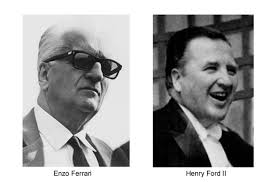With discussions well advanced, Frey got back in touch with Henry II. On May 21, the two teams from either side of the discussion table sat down to a final draft to close the deal. Two entities were going to be created, Ford-Ferrari: A customer car company, 90 percent of which would be owned by Ford, and Ferrari-Ford: The racing team, 90 percent of which would be owned by Ferrari.
Dearborn negotiators knew the latter company was the real deal. Le Mans was the biggest stage in European racing. A win at Le Mans was commercially more important than all other European races combined. Ferrari was king of Europe, and his commercial success was rivalled. If the Ford Motor Company were to successfully penetrate Europe, and dominate it, they had to capture Le Mans, and so they made moves to secure the deal to Ford’s advantage.
Reading the final agreement, something caught Ferrari’s attention. Dearborn representatives knew something didn’t go down well with Ferrari when he drew a large exclamation point at the margin of certain pages.
Turning to Frey “But here, Ferrari said, It is written that if I want to spend more for racing I have to request authorization to do so from America! Is it also written that way in the official English text? Where is the freedom that I demanded right from the start to make programs, select men and decide on money? But Mr. Ferrari, you’re selling your firm, and you pretend still to dispose of it to your pleasure,” Frey replied.
Ferrari questioned, “so if I wish to enter cars at Indianapolis and you do not wish me to enter cars at Indianapolis, do we go or do we not go? You do not go,” Frey replied.
This was a deal breaker for Ferrari. He had worked his entire life bringing sports cars to life and calling the shots on the race track, a deal that would see him stifled out of control was simply out of the discussion. Furious, “My rights, my integrity, my very being as a manufacturer, as an entrepreneur, cannot work under the enormous machine, the suffocating bureaucracy of the Ford Motor Company!” Ferrari shouted. The deal was off.
After months and long hours of talks, Frey couldn’t be more disappointed heading back to the Glass House having lost the deal. He departed Italy for Dearborn the following day, leaving with a copy of The Enzo Ferrari Memoirs: My Terrible Joys, as a parting gift. Back in town, he would find himself in the same room with the Glass House boss. “I failed,” Frey told Ford II.
The duo made their way to the dining room of the penthouse before Frey before provided an in-depth briefing on how discussions panned out in Italy. It was “the longest lunch I ever had in my life,” Frey would later describe the meeting with Henry II.
Listening, Henry II was bottled-up in fury. The unsavoury turn was not expected. But his mission in Europe was not going to be truncated by anyone, including Ferrari.
“All right,” Henry II said. “We’ll beat his ass, we’re going to race him.” Frey knew something big was about to unfold, and he’d play an integral role in it.
“How much money do you want to spend?” then, Frey asked his boss.
“I didn’t say anything about money,” Henry II responded.
The point was clear to Frey. Henry II was ready for the challenge no matter the cost, bankrolling the project was not a problem, and finishing second was not an option. Aware of Ford II’s next move, lacocca assembled his team and developed a proposal for a new special-vehicles department. Its purpose – to design and build the fastest, most reliable and technologically advanced racing car in history. Another fight was born; Ford II was leading America to an unchartered territory – a quest to beat Enzo Ferrari at Le Mans.


